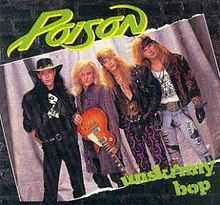"Unskinny Bop" is a song by American glam metal band Poison, which was released as the first single from their 1990 Flesh & Blood album.
The song peaked at number 3 on the US Billboard Hot 100, number 5 on the Mainstream rock charts,[1] number 15 in the UK[2] and #7 on the Australian charts. This made it the band's second highest success, after "Every Rose Has Its Thorn". The music video for the song has Bret Michaels dancing with a couple of animated neon cowgirls next to him.
Background
The meaning of "Unskinny Bop" has always been shrouded in obscurity. C.C. DeVille later confessed that the phrase "unskinny bop" has no particular meaning. He invented it as a temporary measure while writing the song, before vocalist Bret Michaels had begun working on the lyrics. The phrase was used on the basis that it was phonetically suited to the music. The song was later played to producer Fairbairn, who stated that, although he did not know what an "unskinny bop" was, the phrase was perfect.[3]
Trivia
- The song appeared as a playable track in the music videogame Guitar Hero: Warriors of Rock and as a downloadable track in Rock Band 3.
- It is featured in the episode "Tom's Divorce" of Parks and Recreation.
- It is featured in the episode "Stewart Is Missing" of Beavis and Butt-Head.
- On the HBO series Eastbound & Down, Kenny Powers used the song as his entrance theme while riding on a donkey to the field and throwing beer to the crowd
- In his book A Lion's Tale: Around the World in Spandex, professional wrestler Chris Jericho states that he used Unskinny Bop as his entrance theme in his first professional match, and continued to use it as theme music while wrestling on the Canadian independent circuit in the early 1990s.
Chart performance
Peak positions
| Chart (1990) |
Peak
position |
| Australian ARIA Charts |
7 |
| Canadian RPM Top Singles |
3 |
| Dutch Mega Top 50 |
34 |
| New Zealand Singles Chart |
3 |
| Swedish Singles Chart |
19 |
| UK Singles Chart |
15 |
| U.S. Billboard Hot 100 |
3 |
| U.S. Billboard Hot Mainstream Rock Tracks |
5 |
|
End of year charts
| End of year chart (1990) |
Position |
|---|
| U.S. Billboard Hot 100[4] |
32 |
|
References
External links
|
|---|
| | | | Studio albums | |
|---|
| | Live albums | |
|---|
| | Compilations | |
|---|
| | Videos | |
|---|
| | Singles | |
|---|
| | Solo albums | |
|---|
| | Related articles | |
|---|
|
